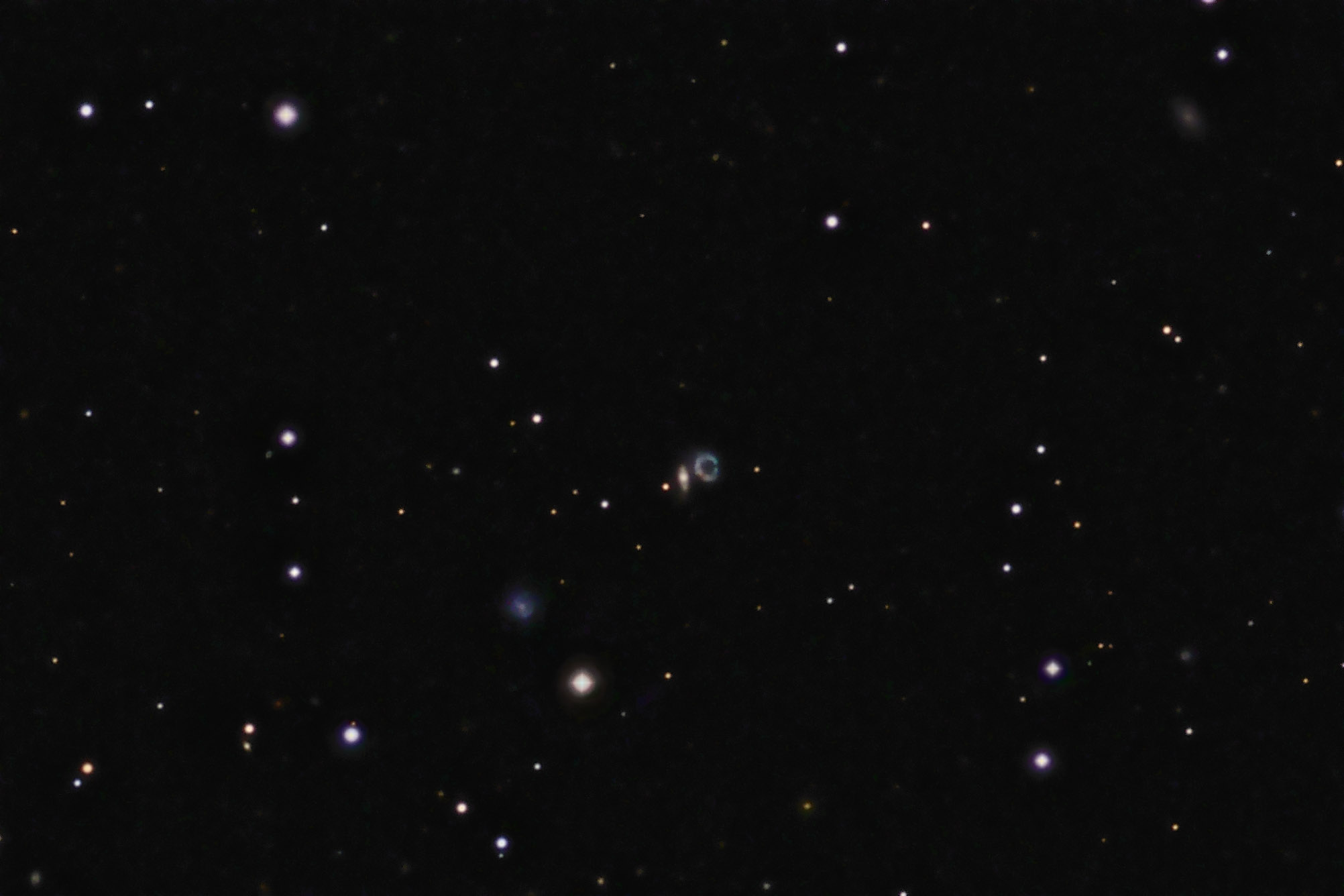Object name: ARP147 Seems the same time Hubble was taking this object, Arp 147, a pair of ring galaxies, so was I. The pair is also known as IC 298 so even the IC catalog has this as one object. It was discovered by Stephane Javelle on December 29, 1893.
With no backlog to process and no wood to cut -- we pulled down yet another "widow maker" from our vast mess created from this summer's tornado which missed us "by that much", and cut it up into fireplace lengths -- Hubble was able to process their version and rush it to the news media. So while imaging another Arp galaxy I did a quick process of my version of the same object. Though in my case it is more "a perfect .10" Obviously theirs is better but the real reason for downgrading mine by a factor of 100 is that the star beside the two galaxies is far more prominent in my image than theirs and is in the right spot for a decimal point. Also, I'd like to point out my telescope cost several billion dollars less than theirs and needs no shuttle to service it. So there!
The Hubble version, in case you have been down a rabbit hole, is at:
http://hubblesite.org/newscenter/archive/releases/2008/37/
Note that their image is not really true color as it used blue for the blue channel, white light for the green channel and infrared for the red channel. This makes for stronger reds and blues than if seen by the human eye. I used true color filters so this should be pretty much the correct colors if your eye could see color in such a faint object. Note that getting closer doesn't help. It just gets bigger at the same rate we see more total light. Spreading that extra light over the extra area just makes it the same brightness. So no matter how close you get to it the human eye wouldn't see color, it would always be too faint. Surprising but true. So I guess it really doesn't matter how the colors are mapped. Black and white is the only "true color" for this object and most others I feature.
It appears the galaxy on the left has passed right through the one on the right. That is, the one passed through the other turning it into a zero. In the process, the one was distorted so as to have two rings rather than spiral arms that it likely had before so it too is considered a ring galaxy. In my shot, it too looks a bit like the "Saturn Galaxy" in a recent update. The reddish part of the ring toward the bottom left was likely the core of the now zero galaxy prior to the collision. Its strong blue color is due to rapid star formation triggered by the collision. It looks like the "one" galaxy was stripped of its dust and gas by the collision so has no raw materials for star formation. Considering its slightly overall red color it likely had used up most of its dust and gas long ago and hasn't had much active star formation for a billion years or so. The pair is thought to be about 400 million light-years from us. The small blue galaxy down and left of my "perfect .10" is UGCA 057. I can find nothing on it, however.
About that big galaxy in the upper right corner... Unfortunately, it is one of those with no info available other than its catalog name of APMUKS(BJ) B030818.97+011155.2. You'd think more would be known about such a big guy but apparently not.
The nice thing about this is that Hubble didn't image these guys, only Arp 147 so maybe I scooped Hubble after all.
My shot was taken at 0.5" per pixel rather than my normal 1" per pixel as this is one small object. Seeing that night wasn't all that good but better than I normally get so doubt I'll go back and try again. Besides, Hubble has me beat on this one anyway. Can't fight its multi-billion dollar bankroll!
I cropped the image to show just the center one-quarter of the total image area as there wasn't much of interest in the rest of the image. Also, this crop makes it the same physical size as my 1" per pixel images. Thus keeping bandwidth for emails at a manageable level.
Arp's version is at:
http://ned.ipac.caltech.edu/level5/Arp/Figures/big_arp147.jpeg
14" LX200R @ f/10, L=6x20'x1 RGB=3x10'x2, STL-11000XM, Paramount ME Related Designation(s):ARP 147, ARP147, CGCG 0308.7+0108, CGCG 390-016, CGPG 0308.7+0108, I Zw 011, IC 0298, IRAS 03087+0107, IRAS F03087+0107, MCG +00-09-015, NVSS J031118+011854, PGC 011890, VV 787, [ISI96] 0308+0107, | | 
